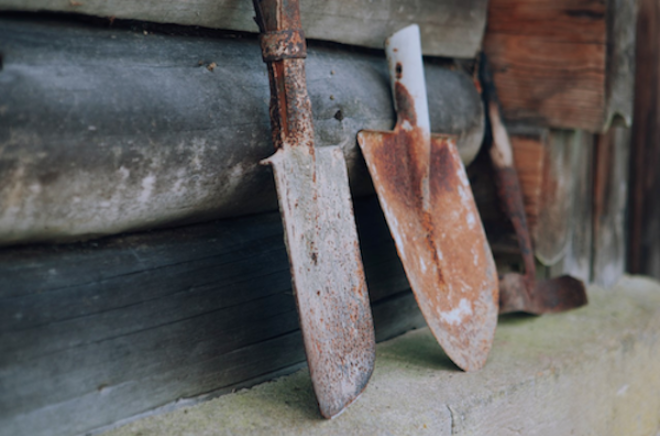Once again, I’m here at a hardware store, oddly inspecting at-attention shovels standing their platoon. Each shovel is in their designated cubbies and holes, one next to the other, like vertical coffins. Some appear homespun in length and with hickory handles, built with pride by the Richland Company in Arkansas. Others sport Andy Warhol yellow-and-orange fiberglass shafts, manufactured in places like Bristol, Virginia and Pittsburg, Pennsylvania.
To the right stands a formation of shorter shovels with thick grips, meant to accommodate blue-collar callused hands, lacquered with sticky ambition.
My local ACE hardware boasts broad ones too, for down under the snow and ice. There’s even a few dressed in the vintage colors of tuxedoes, white and black, an Art Deco to accommodate the elegance of a twentieth-century six-foot depth.
Three of the shovels are narrow. They fit deep rectangular holes that stretch into forever like a Kansas road. Two stand conspicuous, serious about hollowing paths in deep snow. All the shovels carry themselves with such spree décor, distinguished with engraved names: Ames, Seymour, and Bond.
As far as I can tell, the majority are designed to excavate a variety of dirt, excavating width and length of what once was whole. All are well-crafted for displacement and for digging any specification or design of underneath. I imagine most of their 21st century résumés nearly perfect: light use, one year warranty, each assured of long life or replacement if broken.
~
Before the armies of yellow backhoes, shovels caught most notoriety, they were so dignified in lexicon. In their heyday, they buried the strong, the fragile, the children. They were tasked to perform conventional duties, predictably somber. Services were dignified, meant to honor, burial poems were often welcomed.
Based on my previous trips, I’ve concluded that most contemporary shovels have been designed with avocations and chores in mind, with lesser ambitions rarely affiliated with scoops of death. More often than not, the newer shovels are less stout, a better fit for renewal like planting and gardening. Like woody green plants themselves, these shovels mostly bud and bloom in the spring. Their pedestrian tasks include the displacement of potting soil, the planting of carrots, radishes, and tomatoes. They have been purposed for civilian use, digging a redwood fence post hole or two.
~
As a child, I’d assigned myself an inquisitive shovel to help dig up the past. I forget the name of the brand, but it’s the one most curious boys utilize to dig after dreams, or the devils horns. I was curious, and so I’d convinced myself to dig clear through to Beijing, China, use chopsticks for a lunch of noodles, all through a portal I’d fashioned in Mother’s flower bed.
As I grew older, I uncovered the real reason mother had assigned me to her treasured garden. Why she’d only given a cooking spoon to dig.
She purchased time, and boy was it expensive. Time to gather herself after the Chaplin had left.
I knew exactly what happened to my father in Vietnam. When he crashed he’d shattered mother’s heart into pieces all over the living room hardwood.
As I grew into adulthood, I found it challenging to keep the past buried, especially having an obsession with excavation. A divorce will do that to you. I must admit, now that I’m older, I’ve been more interested in prospecting, unearthing the devilish details of yore.
~
In the Civil War, chaplains comforted the living and rolled up their sleeves to help bury young soldiers and slaves, severed elbows and legs, and dead stallions in fields where fifes played Dixie and drums beat Yankee Doodle Dandy—instruments of love and hate.
In World War Two at Normandy, shovels attended the honorable. It is there, in spring, the locals compel tourists not to stare at the hills, partially dressed in mustards and yarrow, “The blossoms will blind you like the Sun.”
In Vietnam, shovels dug foxholes for G.I.’s who lay in fetus positions, glowing from the VC rockets’ red glare, their bombs bursting thin air. They lay crazed and low in the dampness dirt through the dawns early light, begging for their mothers.
~
As I fix my eyes on all the hardware department shovels, they begin to dissolve into vapor as a series of fluorescents across the high ceiling begin their tick, tick, and ticking off. They switch out, row after row.
At the same time, I imagine the light emitting diodes automatically switching on, row after row, at Arlington National Cemetery. Not one soldier is awakened by the lights.
The store clerks are impatient, they pace the isles, insisting I leave so they can close the hardware store and speed home to their waiting families.
I inexplicably quicken the math in my head. I dare to calculate how many shovels await their toss, how many bloodied scoops of soil would it take to fill the craters that pock the moon?
Dan A. Cardoza
Dan’s poetry, fiction, and nonfiction have or will appear in Across the Margin, After the Pause, Apricity, BlazeVOX, Bull, Cleaver, Entropy, Gravel, Hamilton Stone Review, In Parentheses, Open Journal of Arts & Letters, New Flash Fiction Review, Poetry Northwest, Running Wild Press Anthology, 2021, Spelk, and Your Impossible Voice. He was nominated for Best Micro Fiction, Tiny Molecules, 2020 and Best Poetry, Coffin Bell, 2020.








